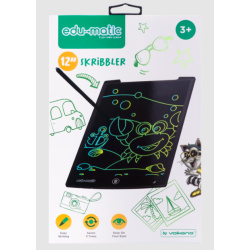Ages 10 and up
STEAM/STEM - Digital making for Young Makers. Never too young to learn....
The main difference between STEM and STEAM is STEM explicitly focuses on scientific concepts. STEAM investigates the same concepts, but does this through inquiry and problem-based learning methods used in the creative process.
The main difference between STEM and STEAM is STEM explicitly focuses on scientific concepts. STEAM investigates the same concepts, but does this through inquiry and problem-based learning methods used in the creative process.
micro:bit V2 (20 units) classs bundle with Duracell batteries (mbit V2 classx20 bundle)
The BBC micro:bit is a pocket-sized codeable computer with motion detection, a built-in compass, LED display, and Bluetooth technology built in. V2 now with microphone and speaker
micro:bit V2 Essentials Kit with Jumpers and Duracell batteries (m:bit V2 Ess kit batt)
The BBC micro:bit is a pocket-sized codeable computer with motion detection, a built-in compass, LED display, and Bluetooth technology built in. V2 now with microphone and speaker
micro:bit V2 Junior Kit (micro:bit V2 Junior)
The BBC micro:bit is a pocket-sized codeable computer with motion detection, a built-in compass, LED display, and Bluetooth technology built in. V2 now with microphone and speaker
BBC micro:bit V2.21 - Next Gen Classroom Pack(30pc) including watch straps (mbitV2.21 class30)
The micro:bit board is a product by the micro:bit Educational Foundation, the non-profit that aims to inspire every child to create their best digital future.
Volkano Kids Doodle Series 8.5-inch Writing And Drawing Board VK-850-BK (VK Kids doodle)
Fun for the whole family to use. Encourage your child's creativity without the mess or use it yourself for lists.
EDU-MATIC SKRIBBLER – 12INCH LCD WRITING TABLET (VK SKRIBBLER 12")
Fun for the whole family to use. Encourage your child's creativity without the mess or use it yourself for lists.
Kitronik Arcade for micro:bit - MakeCode ARCADE (Excluding micro:bit) (KT Arcade mbit)
The Kitronik ARCADE for micro:bit is a fully assembled, compact and powerful gamer.
Kitronik Craft and Code for the BBC micro:bit (KT craft and code)
The Kitronik Craft & Code for BBC micro:bit is a fun and engaging way for students to learn about coding as part of wider craft-based projects. Using any version of the BBC micro:bit, this board allows beginners 8+ to design and control various craft projects using MakeCode for micro:bit.
BBC micro:bit Wearable Wrist Strap Accessory - Single Pack (mbit wear watch x1)
The micro:bit wearable kit allows the user to perform movement-based tasks in projects. Ideal for machine learning/AI-based projects, or any project that requires you to be on the move!
Kitronik Mai-Z the MouseBot for BBC micro:bit (not included) (KT Mai-Z MouseBot)
Smart, playful, and packed with potential, meet Mai-Z, the ultimate programmable robot buggy for young coders aged 8–14! Whether it’s drawing shapes, following paths, or responding to motion, your young learners are in the driver’s seat, literally!
- 1




















